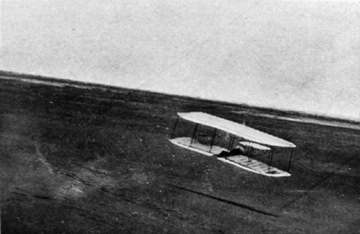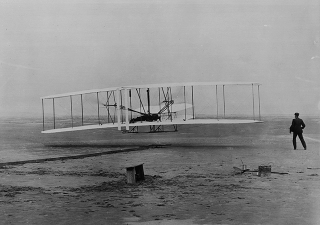The Wright Brothers: Air Pioneers
Part 2: Persistence to Success The Wrights wanted more, of course, and built a better glider that had a rudder, to steer with. One of their gliders stayed aloft a time, flying more than 600 feet. But they still came down, no matter what the person aboard did. The Wrights wanted to make a machine such that the pilot could control when the machine would land. They had thought of engines, of course, like the ones in factories. But these engines were much too big. Orville and Wilbur finally decided to make an engine that would be small enough and light enough to power one of their gliders. With their mother's love of tinkering and their own curiosity driving them, they made an engine that would fit the bill and installed it on their newest glider.
So it was on December 14, 1903, that Wilbur Wright made the first experiment with the new man-powered airplane flight. The flight didn't last long and ended in a crash, which took the Wrights a few days to repair. And it is worth nothing that the plane got up its momentum on this attempt by gliding down a monorail from the top of a hill. (The plane had wheels, remember, and so it rolled down the rail, just like a bicycle.) Wilbur was the pilot that day. The brothers had flipped a coin to see who would go first. After repairing the plane, Orville and Wilbur decided to put the track on flat ground. This would allow Wilbur to run alongside the plane as it was gaining speed and keep the right wing steady. (Because the plane had been going downhill on the first attempt, Orville couldn't keep up and so Wilbur had had With the coin flip results intact (meaning that it was Orville's turn to fly), the little plane was launched on December 17. Wilbur pushed, Orville pedaled, and the plane rose in the air. It was aloft for 12 seconds and went 120 feet, but it was official: The Wright brothers had a machine that could fly. Next page > A Legacy in the Air > Page 1, 2, 3 |
|
Social Studies for Kids
copyright 2002–2026
David White



 The Wrights had chosen Kitty Hawk, North Carolina, as a place to test their plane. This spot had lots of wind, and it had a large sand dune, that would hopefully catch the plane if something went wrong. They had been coming to Kitty Hawk for a few years, testing gliders and other ideas. They had built more complicated machines all the time.
The Wrights had chosen Kitty Hawk, North Carolina, as a place to test their plane. This spot had lots of wind, and it had a large sand dune, that would hopefully catch the plane if something went wrong. They had been coming to Kitty Hawk for a few years, testing gliders and other ideas. They had built more complicated machines all the time. to try to steer the plane himself. Not being familiar with how to do such a thing, Wilbur did too much and plane quickly hit the ground.)
to try to steer the plane himself. Not being familiar with how to do such a thing, Wilbur did too much and plane quickly hit the ground.)
